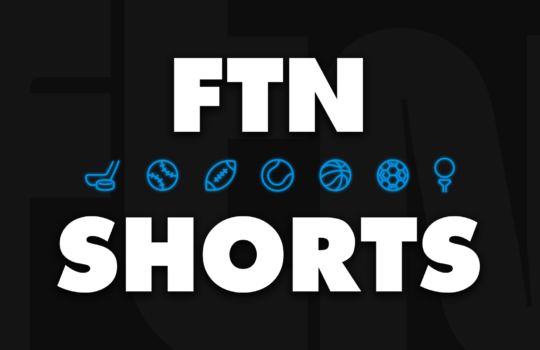
Every Monday, I find myself in a bit of NFL data purgatory. We’re waiting for the week to come to a proper ending, and the data is still yet to be finalized. It’s a great time, however, to look at some historical trends and do some digging on some things we can leverage in the upcoming week. This piece will be out on Tuesdays, but it won’t have the same format or topic each week. The formula will change as I poke around with the data we have access to here. It’ll just be my musings on something that caught my eye. If there’s something to it, I’ll give you some way to leverage the conclusions in fantasy for the upcoming week.
What does it mean to “Take The Points”?
This is my least favorite phrase in football. “Take the points”. We think of football as an up-and-down-the-field game with plenty of opportunities to score. The fact of the matter is, though, that isn’t true. While there are instances where a team can earn an “extra” possession (turnover, recovered onside kick, etc.), you’re quite limited by the machinations of the game. It’s not exactly the same, rigid way that baseball has exactly 27 outs in regulation, but the point is that you don’t get unlimited possessions in the NFL. Because of that dynamic, “taking the points” extends the game but doesn’t actually do anything to improve your win probability.
Old-school football guys will try to convince you that strategies like “making it a one-score game” and “taking the points” work to keep you in the game. The great thing about garbage narratives and anecdotes is that we can prove them wrong with just a little digging. Let’s start with a bird’s eye view of the situation.
If we broadly call “taking the points” any time you kick a field goal while you’re down by 4 to 11 points, the results are atrocious. These cutoffs might seem arbitrary. The point, though, is to take a look at a team’s intent. If a team is down 11 and attempting a field goal, they’re trying to make it a one-score game. If a team is down 4 and attempting a field goal, they’re going to still be down by 1 point even if they make it. NFL teams are doing this consistently across the league.
Just how bad is it to “take the points?”
Teams that attempt one of these TTP field goals have gone on to win just 497-of-1,774 (28%) games since 2010. That might seem like it’s lacking context and you may argue that teams that are willing to “take the points” are probably underdogs who are just looking to stay in the game. When you look at underdogs, they’re 189-of-1,017 (18.5%). That’s significantly lower than when you look at favorites. Favorties are 308-of-757 (40.6%).
People make mistakes! That’s fine. We want to avoid the big mistakes. While it appears (by looking at the result of the game) that these are big mistakes, we need to figure out a way to quantify these decisions. Luckily, we have a little something called “Win Probability Added.” It’s a metric that calculates the likelihood that you win a game after the result of the play is known and compares it to your win probability at the time of the snap.
These plays are largely neutral at best. In fact, the average Win Probability Added of these plays is -0.2%. The best TTP play since 2010 resulted in a 13.7% increase in win probability while the worst such play equated to a 14% decrease in win probability.
Outsized returns
On the whole, the numbers for teams that go for it aren’t much better from a result perspective. Teams, overall, are 243-for-1,000 (24.3%) when they go for it in those situations. Underdogs are 98-for-547 (17.1%) which is basically in line with the teams that elected for field goals. Favorites are 145-for-426 (34%). Again, all of these numbers are similar, so why should we care?
The range in Win Probability Added is the untapped resource here. Only 131-of-2,543 (5.2%) plays where a team took the points resulted in a win probability increase of 6% or more. When teams go for it in these situations, they’ve eclipsed that mark in added win probability 281-of-1,311 (21.4%). When you find yourself behind by as many as 11 points in a game, you’re already behind the 8-ball. Taking the points might keep you in the game for longer but it doesn’t appreciably increase your likelihood of winning the game.
Who’s taking points the most this year?
It’s a bit of a mixed bag with the leaders here, but the teams that are doing our specific example of taking the points aren’t exactly lighting the world on fire. There are only a couple of teams in the top ten that look like they have any chance of making some noise in the playoffs. When teams realize that they aren’t gaining much from kicking these field goals, we’ll see more comebacks and a more interesting brand of football.

















































 New York Jets
New York Jets  New England Patriots
New England Patriots  Miami Dolphins
Miami Dolphins  Buffalo Bills
Buffalo Bills  Pittsburgh Steelers
Pittsburgh Steelers  Cleveland Browns
Cleveland Browns  Cincinnati Bengals
Cincinnati Bengals  Baltimore Ravens
Baltimore Ravens  Tennessee Titans
Tennessee Titans  Jacksonville Jaguars
Jacksonville Jaguars  Indianapolis Colts
Indianapolis Colts  Houston Texans
Houston Texans  Las Vegas Raiders
Las Vegas Raiders  Los Angeles Chargers
Los Angeles Chargers  Kansas City Chiefs
Kansas City Chiefs  Denver Broncos
Denver Broncos  Washington Commanders
Washington Commanders  Philadelphia Eagles
Philadelphia Eagles  New York Giants
New York Giants  Dallas Cowboys
Dallas Cowboys  Minnesota Vikings
Minnesota Vikings  Green Bay Packers
Green Bay Packers  Detroit Lions
Detroit Lions  Chicago Bears
Chicago Bears  Tampa Bay Buccaneers
Tampa Bay Buccaneers  New Orleans Saints
New Orleans Saints  Carolina Panthers
Carolina Panthers  Atlanta Falcons
Atlanta Falcons  San Francisco 49ers
San Francisco 49ers  Seattle Seahawks
Seattle Seahawks  Los Angeles Rams
Los Angeles Rams  Arizona Cardinals
Arizona Cardinals 





 Boston Celtics
Boston Celtics  Brooklyn Nets
Brooklyn Nets  Philadelphia 76ers
Philadelphia 76ers  New York Knicks
New York Knicks  Toronto Raptors
Toronto Raptors  Chicago Bulls
Chicago Bulls  Detroit Pistons
Detroit Pistons  Milwaukee Bucks
Milwaukee Bucks  Cleveland Cavaliers
Cleveland Cavaliers  Indiana Pacers
Indiana Pacers  Orlando Magic
Orlando Magic  Atlanta Hawks
Atlanta Hawks  Charlotte Hornets
Charlotte Hornets  Miami Heat
Miami Heat  Washington Wizards
Washington Wizards  Denver Nuggets
Denver Nuggets  Minnesota Timberwolves
Minnesota Timberwolves  Oklahoma City Thunder
Oklahoma City Thunder  Portland Trail Blazers
Portland Trail Blazers  Utah Jazz
Utah Jazz  LA Clippers
LA Clippers  Golden State Warriors
Golden State Warriors  Los Angeles Lakers
Los Angeles Lakers  Phoenix Suns
Phoenix Suns  Sacramento Kings
Sacramento Kings  Dallas Mavericks
Dallas Mavericks  Houston Rockets
Houston Rockets  Memphis Grizzlies
Memphis Grizzlies  New Orleans Pelicans
New Orleans Pelicans  San Antonio Spurs
San Antonio Spurs 










